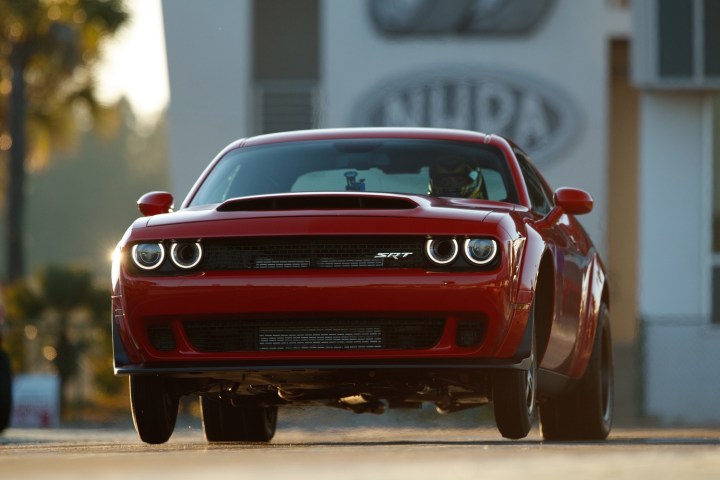
During the Demon reveal ahead of the 2017 New York Auto Show, Dodge boss Tim Kuniskis bragged about a competition ban by the National Hot Rod Association (NHRA), the organization that governs most drag racing in the U.S. But that’s not exactly the case.
In testing at Gainesville Raceway in Florida, the NHRA certified that the Demon is capable of running the quarter mile in 9.65 seconds at 140 mph, which Dodge says makes it the fastest production car in the quarter mile ever. Drag races are traditionally held over a quarter-mile straight track, and any time under 10 seconds is extremely quick for a production car.
So quick, said Kuniskis, that the NHRA then sent Dodge a certified letter banning the Demon from competition. While that may seem like a problem for a car built specifically for drag racing, Kuniskis said the letter was a good thing. He views it as proof of the Demon’s status as the most extreme production muscle car ever.
However, if you buy a Demon, the NHRA will let you race it. It will just require a little more effort than simply showing up at a drag strip.
Current NHRA rules allow 2008 and newer vehicles to run as fast as 10 seconds and 135 mph in stock form. Any faster than that, and the NHRA requires the fitment of extra safety equipment, Glen Gray, NHRA Vice President—Technical Operations and the man who wrote the “ban” letter, explained in a post on the organization’s website.
Any car running 9.99 seconds or quicker needs to have “certain NHRA-certified equipment, including, but not limited to, a certified roll cage, window net, aftermarket driver restraint system, a driveshaft loop, and a master cutoff switch,” according to the NHRA post. The Demon doesn’t come with any of that, although it does have four-point harnesses in place of conventional three-point seatbelts. The driver must also have an NHRA competition license, and wear a full complement of safety gear, including a helmet, fire-resistant clothing, and a HANS device or similar neck collar.
The NHRA pointed out that, just because doesn’t Dodge doesn’t sell the Demon with any of the required safety equipment, that doesn’t prevent owners from installing it and taking their cars to the drag strip. Fit your Demon with a roll cage and the other addenda, get an NHRA competition license, and you’re good to go. But doing that also sort of defeats the purpose of a drag-raceable production car.
Dodge’s Kuniskis is adamant that the Demon is a car you can drive around town in between running blisteringly fast quarter-mile times at the track, but the need to add racing safety equipment compromises any practicality the car might have. Sure, Dodge will restore the passenger seats it removed in the interest of weight savings, but no one is going to want to climb over a roll cage to get into them—assuming there is even room for both.
Every enthusiast dreams of a street-legal race car, but given how fast cars are getting and how seriously sanctioning bodies take both safety and liability, that requires a lot of compromises. The NHRA’s decision is a smart one; the Demon is a seriously quick car, after all. Dodge is also right to be proud of its demonic creation; there has never been anything like it. But owners will have to decide if they want their Demons to be street cars or race cars.


